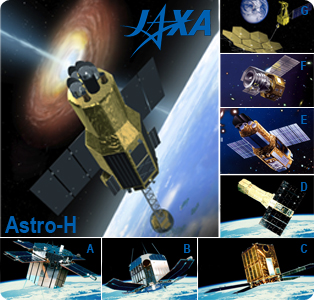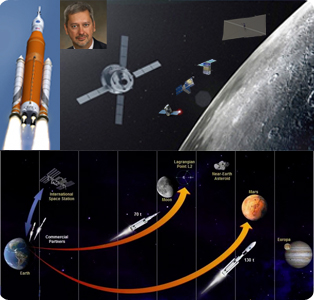Japan Space Astronomy and 21st Century Exploration Advancing
Launch of Astro-H Astronomy Satellite from Tanegashima Space Center, Japan aboard the 30th H-2A rocket is indicative of a greater expansion of Astronomy into Space, both with satellites and lunar missions. Initial countdown toward Feb 12 launch is scrubbed due to inclement weather, next available window to be announced. Reaching its designated orbit at 575-km altitude to begin conducting X-ray and gamma-ray observations of some of the most powerful phenomena in the Universe, it will become known by an as-of-yet unannounced new official name. The primary objective is to explore the structure and evolution of the Universe by studying objects such as supernova explosions, supermassive black holes, and galaxy clusters. One stated goal is to elucidate dark matter and dark energy. The project is lead by JAXA and includes participation of more than 200 researchers at 70 contributing institutions in Japan, the USA, Canada, and Europe. The Astro-H space observatory is 10-100 times more sensitive than its predecessor, 14 meters in length when fully extended and with a mass of 2,400 kg is the heaviest of 8 total that Japan has developed (only seven launched; Astro-G was cancelled). Japan seems to specialize in space-based X-ray astronomy; Astro-A through E, now known as Hinotori, Tenma, Ginga, ASCA, and Suzaku, have all been X-ray observatories. The exceptions Astro-F and G, were designed for Infrared astronomy and radio astronomy respectively. National Astronomical Observatory of Japan is hosting the International Lunar Observatory Association public education event known as Galaxy Forum, at their Mitaka, Tokyo headquarters, including participation of JAXA lunar exploration representatives, Japan space enterprise leaders, NAOJ astronomy experts and former Astronaut Naoko Yamazaki. (Image Credit: JAXA, Space Age Publishing Company)
|
MONDAY
|

![]() = All times
= All times
for terrestrial events in local time unless noted.
![]() = All times for international terrestrial events in local time unless noted.
= All times for international terrestrial events in local time unless noted.
![]() = All times for space events, and…
= All times for space events, and…
![]() = All times for international space / astro events in Hawaii Standard Time unless noted. Add 10 hours to obtain UT (‘Universal Time;’ Greenwich, England).
= All times for international space / astro events in Hawaii Standard Time unless noted. Add 10 hours to obtain UT (‘Universal Time;’ Greenwich, England).
Weekly Planet Watch – Evening Planets: Jupiter (E), Uranus (W); Morning Planets: Mercury (SE), Venus (SE), Mars (S), Saturn (SE).
SLS, Orion, EM-1 CubeSats Promise Innovative Moon / Deep Space Science and Technologies
|
Continued from…
TUESDAY
WEDNESDAY
|
![]() Feb 17 — Rutgers Hillel Center for Israel Engagement, Rutgers University, New Brunswick NJ: Update on GLXP SpaceIL; presented by SpaceIL engineer / co-founder Yonatan Winetraub.
Feb 17 — Rutgers Hillel Center for Israel Engagement, Rutgers University, New Brunswick NJ: Update on GLXP SpaceIL; presented by SpaceIL engineer / co-founder Yonatan Winetraub.
![]() Feb 17-19 — Japan Ministry of Education, Culture, Sports, Science & Technology, Sapporo, Hokkaido, Japan: Solar-System Symposium; at Rusutsu Resort.
Feb 17-19 — Japan Ministry of Education, Culture, Sports, Science & Technology, Sapporo, Hokkaido, Japan: Solar-System Symposium; at Rusutsu Resort.
![]() Feb 17-19 — Swiss National Science Foundation, ETH Zurich, Zurich, Switzerland: Conference: The X-ray View of Black Hole Activity in the Local Universe.
Feb 17-19 — Swiss National Science Foundation, ETH Zurich, Zurich, Switzerland: Conference: The X-ray View of Black Hole Activity in the Local Universe.
![]() Feb 17-19 — Arizona State University, NExSS, NASA Astrobiology Institute, NSF, Tempe AZ: Upstairs Downstairs: Consequences of Internal Planet Evolution for the Habitability and Detectability of Life on Extrasolar Planets.
Feb 17-19 — Arizona State University, NExSS, NASA Astrobiology Institute, NSF, Tempe AZ: Upstairs Downstairs: Consequences of Internal Planet Evolution for the Habitability and Detectability of Life on Extrasolar Planets.
![]() Feb 17 — Moon: 6.1° S of M35, 14:00.
Feb 17 — Moon: 6.1° S of M35, 14:00.
THURSDAY
![]() Feb 18 — The National Academies, Washington DC / Online: NASA Technology Roadmaps Teleconference.
Feb 18 — The National Academies, Washington DC / Online: NASA Technology Roadmaps Teleconference.
![]() Feb 18 — British Interplanetary Society, London, United Kingdom: Lecture: Skylab – Designing the First Large-Scale Space Station; Colin Ledsome.
Feb 18 — British Interplanetary Society, London, United Kingdom: Lecture: Skylab – Designing the First Large-Scale Space Station; Colin Ledsome.
![]() Feb 18 — Cornell University, Ithaca NY: Lecture: Blown Away; Ralph Lorenz from JHU/APL discusses research topics on wind in planetary environments.
Feb 18 — Cornell University, Ithaca NY: Lecture: Blown Away; Ralph Lorenz from JHU/APL discusses research topics on wind in planetary environments.
![]() Feb 18 — Apollo Asteroid 2016 CG137: Near-Earth flyby (0.056 AU).
Feb 18 — Apollo Asteroid 2016 CG137: Near-Earth flyby (0.056 AU).
![]() Feb 18 — Apollo Asteroid 2016 CA138: Near-Earth flyby (0.064 AU).
Feb 18 — Apollo Asteroid 2016 CA138: Near-Earth flyby (0.064 AU).
![]() Feb 18 — Apollo Asteroid 1999 VF22: Near-Earth flyby (0.094 AU).
Feb 18 — Apollo Asteroid 1999 VF22: Near-Earth flyby (0.094 AU).
FRIDAY
![]() Feb 19 — ISS, Cygnus OA4 Unberthing & Release, LEO: Cygnus OA4 to be released at 11:25 UT, live coverage available, for Earth Atmosphere disintegration with ISS waste.
Feb 19 — ISS, Cygnus OA4 Unberthing & Release, LEO: Cygnus OA4 to be released at 11:25 UT, live coverage available, for Earth Atmosphere disintegration with ISS waste.
![]() Feb 19 — Cassini OTM-443, Saturn Orbit: Spacecraft conducts Orbital Trim Maneuver #443 today.
Feb 19 — Cassini OTM-443, Saturn Orbit: Spacecraft conducts Orbital Trim Maneuver #443 today.
![]() Feb 19 — Virgin Galactic, Scaled Composites, Mojave CA: Second SpaceShipTwo roll out and naming; Steven Hawking expected to attend and name newest SpaceShipTwo; company hopes to launch people into space starting 2018.
Feb 19 — Virgin Galactic, Scaled Composites, Mojave CA: Second SpaceShipTwo roll out and naming; Steven Hawking expected to attend and name newest SpaceShipTwo; company hopes to launch people into space starting 2018.
![]() Feb 19 — Made in Space, NASA, Mountain View CA: Media invited to talk to technology experts & tour Made In Space facilities at NASA Research Park, Moffett Field.
Feb 19 — Made in Space, NASA, Mountain View CA: Media invited to talk to technology experts & tour Made In Space facilities at NASA Research Park, Moffett Field.
![]() Feb 19 — Peninsula Astronomical Society, Foothill University, Los Altos Hills CA: Lecture: Evolution of Planetary Landscapes from Callisto to Helene; by Orkan M. Umurhan.
Feb 19 — Peninsula Astronomical Society, Foothill University, Los Altos Hills CA: Lecture: Evolution of Planetary Landscapes from Callisto to Helene; by Orkan M. Umurhan.
![]() Feb 19 — Lunar and Planetary Institute, Houston TX: Lecture: Effects of Mechanical, Rheological and Tectonic Controls on the Formation of Giant Radial Dike Systems on Venus – Insights from Finite Element Modeling; by Nicolas LeCorvec.
Feb 19 — Lunar and Planetary Institute, Houston TX: Lecture: Effects of Mechanical, Rheological and Tectonic Controls on the Formation of Giant Radial Dike Systems on Venus – Insights from Finite Element Modeling; by Nicolas LeCorvec.
![]() Feb 19 — Moon: 14.7° S of Castor, 00:00; 22.2° S of Pollux, 05:00.
Feb 19 — Moon: 14.7° S of Castor, 00:00; 22.2° S of Pollux, 05:00.
![]() Feb 19 — Apollo Asteroid 2016 CD137: Near-Earth flyby (0.017 AU).
Feb 19 — Apollo Asteroid 2016 CD137: Near-Earth flyby (0.017 AU).
SATURDAY
![]() Feb 20 — International Lunar Observatory Association, National Astronomical Observatory of Japan (NAOJ), Tokyo, Japan: Galaxy Forum Japan 2016 – Tokyo: 21st Century Frontiers of Astronomy & Observation; at NAOJ Mitaka Campus.
Feb 20 — International Lunar Observatory Association, National Astronomical Observatory of Japan (NAOJ), Tokyo, Japan: Galaxy Forum Japan 2016 – Tokyo: 21st Century Frontiers of Astronomy & Observation; at NAOJ Mitaka Campus.
![]() Feb 20 — British Interplanetary Society, Worcs, United Kingdom: British Interplanetary Society (BIS) West Midland Event; Dave Shayler will talk on Hubble Space Telescope & sign copies of his recent book, Mark Perman will talk about the First German Rocket Research Establishment Kummersdorf; at the Gardeners Arms.
Feb 20 — British Interplanetary Society, Worcs, United Kingdom: British Interplanetary Society (BIS) West Midland Event; Dave Shayler will talk on Hubble Space Telescope & sign copies of his recent book, Mark Perman will talk about the First German Rocket Research Establishment Kummersdorf; at the Gardeners Arms.
![]() Feb 20 — Moon: 5.0° S of Beehive Cluster, 07:00.
Feb 20 — Moon: 5.0° S of Beehive Cluster, 07:00.
![]() Feb 20 — Apollo Asteroid 2016 CO29: Near-Earth flyby (0.040 AU).
Feb 20 — Apollo Asteroid 2016 CO29: Near-Earth flyby (0.040 AU).
SUNDAY
![]() Feb 21-23 — Space Exploration Alliance, NSS, AIAA, Moon Society, Federation of Galaxy Explorers, Planetary Society, SEDS, et al, Washington DC: SEA Legislative Blitz 2016; advocating for the exploration and development of Space.
Feb 21-23 — Space Exploration Alliance, NSS, AIAA, Moon Society, Federation of Galaxy Explorers, Planetary Society, SEDS, et al, Washington DC: SEA Legislative Blitz 2016; advocating for the exploration and development of Space.
![]() Feb 21-27 — National Society of Professional Engineers, AIAA, Boeing Co., SAE International, Nationwide USA: 65th Annual Engineers Week (2016); held during week of George Washington’s birthday, observed by more than 70 engineering, education, cultural societies & more than 50 corporations and government agencies.
Feb 21-27 — National Society of Professional Engineers, AIAA, Boeing Co., SAE International, Nationwide USA: 65th Annual Engineers Week (2016); held during week of George Washington’s birthday, observed by more than 70 engineering, education, cultural societies & more than 50 corporations and government agencies.
![]() Feb 21 — Mercury: At aphelion (distance 0.4667 AU from Sun), 07:00.
Feb 21 — Mercury: At aphelion (distance 0.4667 AU from Sun), 07:00.

